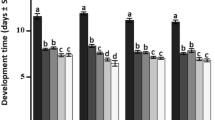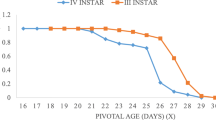Abstract
Laboratory studies were conducted to assess several life-history characteristics of three Trichogramma species—T. cacoeciae, T. evanescens, and T. principium—reared on potato tuber moth eggs. The effects of host age, parasitoid age, and different temperatures on the mean number of parasitized eggs and the percentage of emerged progeny were determined. The age of both Trichogramma and host eggs significantly affected the number of eggs parasitized by the wasps, but did not affect the percentage of parasitoids emerging from parasitized eggs. No intraspecific differences for potato tuber moth eggs were found among the tested Trichogramma species. However, T. principium proved to be more effective than T. cacoeciae and T. evanescens in parasitizing host eggs at high temperatures (>33 °C). Trichogramma significantly decreased the number of potato tuber moth F1 emerged progeny when they were released with moths in small cages either over potatoes or potato seedlings.
Similar content being viewed by others
References
Abacus Concept (1994) StatView, version 4.02. Abacus Concepts, Berkeley, CA
Babi A, Al-Nabhan M (1998) Effect of temperatures on some biological characteristics of the Syrian populations of Trichogramma principium Sugonyaev & Sorokina (Hym., Trichogrammatidae). Arab J Plant Prot 16:66–73
Barnay O, Pizzol J, Gertz C, Kienlen C, Hommay G, Lapchin L (1999) Host density-dependence of discovery and exploitation rates of egg patches of Lobesia botrana (Lepidoptera: Tortricidae) and Ephestia kuehniella (Lepidoptera: Pyralidae) by the parasitoid Trichogramma cacoeciae (Hymenoptera: Trichogrammatidae). J Econ Entomol 92:1311–1320
Bourarach K, Hawlitzky N (1989) Comparative study of the biological potential of Trichogramma evanescens Westwood and Trichogramma lutea Girault (Hym.: Trichogrammatidae). Entomophaga 34:95–104
Cabello T, Vargas P (1988) The effect of temperature on the bionomics of Trichogramma cordubensis (Hym., Trichogrammatidae). In: Voegele J, Waage J, Lenteren J van (eds) International Symposium on Trichogramma and other egg parasitoids 2, Guangzhou, 1986. Les colloques de L’INRA 43, INRA, Paris, pp 155–164
Calvin DD, Losey JE, Knapp MC, Poston FL (1997) Oviposition and development of Trichogramma pretiosum (Hymenoptera: Trichogrammatidae) in three age classes of southwestern corn borer eggs. Environ Entomol 26:385–390
Dijken MJ van, Kole M, Lenteren JC van, Brand AM (1986) Host preference studies with Trichogramma evanescens Westwood (Hym., Trichogrammatidae) for Mamestra brassicae, Pieris brassicae, and Pieris rapae. J Appl Entomol 101:64–85
Dillard HR, Wicks TJ, Philip B (1993) A grower survey of diseases, invertebrate pests, and pesticide use on potatoes grown in South Australia. Aust J Exp Agric 33:653–661
Dumal J, Voegele J, Brun P (1975) Les Trichogrammes. II. Unité de production massive et quotidienne d’un hôte de substitution, Ephestia kuehniella Zeller (Lepidoptera, Pyralidae). Ann Zool Ecol Anim 7:45–59
Fenemore PG (1988) Host-plant location and selection by adult potato moth Phthorimaea operculella (Lep., Gelechiidae) : a review. J Insect Physiol 34:175–177
Fournier F, Boivin G (2000) Comparative dispersal of Trichogramma evanescens and Trichogramma pretiosum (Hymenoptera: Trichogrammatidae) in relation to environmental conditions. Environ Entomol 29:55–63
Harrison WW, King EG, Ouzts JD (1985) Development of Trichogramma exiguum and T. pretiosum at five temperature regimes. Environ Entomol 14:118–121
Harwalkar MR, Rananavare HD, Rahalkar GW (1987) Development of Trichogramma brasiliensis (Hym.: Trichogrammatidae) on eggs of radiation sterilized females of potato tuberworm, Phthorimaea operculella (Lep.: Gelechiidae). Entomophaga 32:159–162
Hegazi EM, Khafagi WE, Hassan SA (2000) Studies on three species of Trichogramma. I. Foraging behavior for food or host. J Appl Entomol 124:145–149
Hoffmann MP, Ode PR, Walker DL, Gardner J, Nouhuys SV, Shelton AM (2001) Performance of Trichogramma ostriniae (Hymenoptera: Trichogrammatidae) reared on factitious hosts, including the target host, Ostrinia nubilalis (Lepidoptera: Crambidae). Biol Cont 21:1–10
Hohmann CL, Luck RF, Oatman ER (1988) A comparison of longevity and fecundity of adult Trichogramma platneri (Hymenoptera: Trichogrammatidae) reared from eggs of the cabbage looper and the angoumois grain moth, with and without access to honey. J Econ Entomol 81:1307–1312
Keller MA, Horne PA (1993) Sources of host-location cues for the parasitic wasp Orgilus lepidus (Braconidae). Aust J Zool 41:335–341
Li LY (1994) Worldwide use of Trichogramma for biological control on different crops: a survey. In: Wajnberg E, Hassan SA (eds) Biological control with egg parasitoids. CAB, Wallingford, pp 37–53
Llanderal-Cazares C, Nieto-Hernandez R, Felix-Ramirez N (2000) Reproductive potential of Orgilus sp. (Hymenoptera: Braconidae) a parasitoid of Phthorimaea operculella (Zeller) (Lepidoptera: Gelechiidae). Agrociencia 34:75–82
Monje JC, Zebitz CPW, Ohnesorge B (1999) Host and host age preference of Trichogramma galloi and T. Pretiosum (Hymenoptera: Trichogrammatidae) reared on different hosts. J Econ Entomol 92:97–103
Nagaraja H (1988) Life and fertility tables of some Trichogrammatoidea spp. (Hym.: Trichogrammatidae) under laboratory conditions. In: Voegele J, Waage J, Lenteren J van (eds) International Symposium on Trichogramma and other egg parasitoids 2, Guangzhou, 1986. Les colloques de L’INRA 43, INRA, Paris, pp 221–222
Naranjo SE (1993) Life history of Trichogrammatoidea bactrae (Hymenoptera: Trichogrammatidae) an egg parasitoid of pink bollworm (Lepidoptera: Gelechiidae), with emphasis on performance at high temperatures. Environ Entomol 22:1051–1059
Pak GA (1986) Behavioral variations among strains of Trichogramma spp. A review of the literature on host-age selection. J Appl Entomol 101:55–64
Pratissoli D, Parra JRP (2000) Fertility life table of Trichogramma pretiosum (Hym., Trichogrammatidae) in eggs of Tuta absoluta and Phthorimaea operculella (Lep., Gelechiidae) at different temperatures. J Appl Entomol 124:339–342
Raman KV, Palacios M (1982) Screening potato for resistance to potato tuber worm. J Econ Entomol 75:47–48
Reznik SY, Umarova TY, Voinovich ND (1997) The influence of previous host age on current host acceptance in Trichogramma. Entomol Exp Appl 82:153–157
Saour G, Makee H (1997) Radiation induced sterility in male potato tuber moth Phthorimaea operculella (Lep., Gelechiidae). J Appl Entomol 121:411–415
Schöller M, Prozell S, Al-Kirshi A-G, Reichmuth C (1997) Towards biological control as a major component of integrated pest management in stored product protection. J Stored Prod Res 33:81–97
Schöller M, Hassan SA (2001) Comparative biology and life tables of Trichogramma evanescens and T. cacoeciae with Ephestia elutella as host at four constant temperatures. Entomol Exp Appl 98:35–40
Shelton AM, Wyman JA, Mayor AJ (1981) Effects of commonly used insecticides on the potato tuberworm and its associated parasites and predators in potatoes. J Econ Entomol 74:303–308
Smith SM (1996): Biological control with Trichogramma: advances, successes, and potential of their use. Annu Rev Entomol 41:375–406
Stuart RJ, Polavarapu S (2000) Egg-mass variability and differential parasitism of Choristoneura parallela (Lepidoptera: Tortricidae) by endemic Trichogramma minutum (Hymenoptera: Trichogrammatidae). Ann Entomol Soc Am 93:1076–1084
Symington CA (2003) Lethal and sublethal effects of pesticides on the potato tuber moth, Phthorimaea operculella (Zeller) (Lepidoptera: Gelechiidae) and its parasitoid Orgilus lepidus Muesebeck (Hymenoptera: Braconidae). Crop Prot 22:513–519
Acknowledgements
We would like to thank Dr. I. Othman (General Director) and Dr. N. Sharabi for their help and support. This work was supported, in part, by contract no. 10781 of the International Atomic Energy Agency, Joint FAO/IAEA Division of Nuclear Techniques in Food and Agriculture. Vienna, Austria.
Author information
Authors and Affiliations
Corresponding author
Rights and permissions
About this article
Cite this article
Saour, G. Efficacy assessment of some Trichogramma species (Hymenoptera: Trichogrammatidae) in controlling the potato tuber moth Phthorimaea operculella Zell. (Lepidoptera: Gelechiidae). J Pest Sci 77, 229–234 (2004). https://doi.org/10.1007/s10340-004-0058-1
Received:
Published:
Issue Date:
DOI: https://doi.org/10.1007/s10340-004-0058-1




